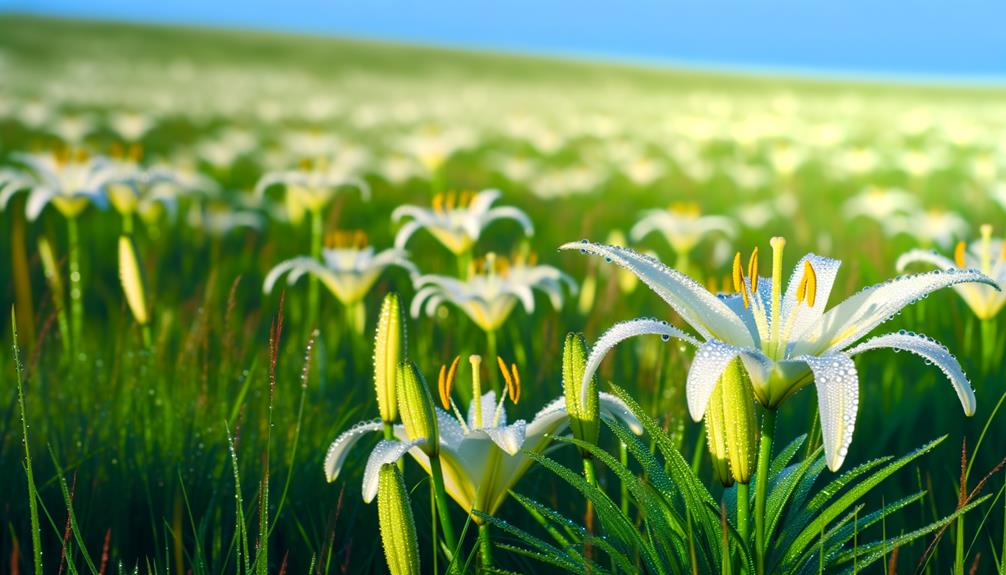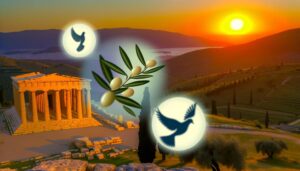Wildflower Meaning In The Bible: Beauty and Humility
In the Bible, wildflowers carry rich theological symbolism. In Matthew 6:28-29, the lilies of the field illustrate divine providence, encouraging trust in God’s care.
The Song of Solomon uses flora to depict divine love and human relationships, while Isaiah 40:6-8 and Psalm 103:15-16 highlight human mortality contrasted with God’s eternal nature. Blossoms in passages like Isaiah 35:1-2 signify spiritual renewal and transformation.
Wildflowers, thriving in harsh conditions, stand as symbols of beauty, resilience, and the ephemeral nature of life, all central themes in biblical teachings. For more profound insights, various scriptural passages reveal deeper interpretations.

Wildflower Meaning in the Bible: Symbolism and Spiritual Significance
| Aspect | Details |
|---|---|
| Symbol of | Beauty, humility, fleeting nature of life |
| Biblical Reference | Matthew 6:28-30 – Consider the lilies of the field |
| Representation | God’s provision and care even for the smallest parts of creation |
| Spiritual Insight | Encourages trust in God rather than worry about material needs |
| Nature Connection | Reflects God’s glory in natural, unadorned beauty |
| Moral Lesson | Value in simplicity and the present moment |
| Theological Message | God’s grace and attention extend to all, not just the powerful or wealthy |
Lilies of the Field

In the Sermon on the Mount, Jesus references the ‘lilies of the field‘ in Matthew 6:28-29 to illustrate God’s provision and care for His creation. This passage highlights a profound theological truth: divine providence extends to all, even the seemingly insignificant.
Jesus contrasts the lilies’ effortless beauty with human anxiety over material needs, urging trust in God’s sustenance. Historically, lilies were abundant in the region, symbolizing purity and divine grace.
Flowers in Solomon’s Song

The Song of Solomon, with its rich tapestry of floral imagery, uses flowers as metaphors to convey the beauty and intimacy of divine love and human relationships.
This poetic book frequently mentions flowers, such as the rose of Sharon and the lily of the valleys, symbolizing the beloved’s purity and grace (Song of Solomon 2:1-2). The historical context reveals a tradition of using floral language to express deep affection and spiritual truths.
- Rose of Sharon: Represents beauty and uniqueness (Song of Solomon 2:1)
- Lily of the Valleys: Symbolizes purity and love (Song of Solomon 2:2)
Understanding these symbols enriches our comprehension of the spiritual and relational dimensions in this sacred text.
The Grass and the Flowers

Many biblical passages use the imagery of grass and flowers to illustrate the fleeting nature of human life and the enduring constancy of God’s word.
Isaiah 40:6-8 poignantly states, ‘All people are like grass, and all their faithfulness is like the flowers of the field. The grass withers and the flowers fall, but the word of our God endures forever.’ This metaphor was particularly resonant in the arid climate of ancient Israel, where the temporary bloom of wildflowers after rain starkly contrasted with the persistent landscape.
Similarly, Psalm 103:15-16 echoes this theme, emphasizing human mortality.
These scriptural references serve to remind believers of the transient nature of earthly existence and the eternal stability offered by divine truths.
Blossoms of Renewal

Amidst the cycles of nature, biblical references to blossoms often symbolize spiritual renewal and divine promise. In Scripture, blossoms frequently denote God’s covenant with His people, emphasizing themes of restoration and hope.
- Isaiah 35:1-2: ‘The desert shall rejoice and blossom as the rose,’ symbolizing transformation and divine intervention.
- Song of Solomon 2:11-12: The blossoming of flowers marks the end of winter, paralleling spiritual awakening and divine love.
Historically, these references underscore the cyclical nature of life and faith, where periods of hardship are followed by divine rejuvenation.
This theological motif affirms that just as flowers bloom anew, so does God’s mercy and grace.
Symbolism of Wildflowers

In biblical literature, wildflowers frequently embody themes of divine beauty, humility, and the fleeting nature of human life.
Isaiah 40:6-8 poignantly states, ‘All people are like grass, and all their faithfulness is like the flowers of the field.’ This metaphor underscores human transience against God’s eternal constancy.
Additionally, Jesus’ Sermon on the Mount (Matthew 6:28-30) highlights wildflowers to illustrate God’s providential care, suggesting that if God so adorns the fields, humanity should trust in His provision.
Historically, wildflowers have thrived in arid, impoverished landscapes, symbolizing resilience and grace under adversity.
Their humble beauty serves as a profound reminder of spiritual truths, urging believers to embrace simplicity and recognize the ephemeral nature of earthly existence.
Conclusion
In scriptural texts, wildflowers symbolize various theological themes, from divine provision in the ‘Lilies of the Field’ (Matthew 6:28) to the ephemeral nature of human life as depicted in Isaiah 40:8.
Historically, wildflowers in Solomon’s Song (Song of Solomon 2:1) represent love and beauty.
An intriguing statistic is that over 90% of plant species on Earth are flowering plants, underscoring their significance in both creation and biblical metaphor. Such statistics evoke awe for the Creator’s intricate design.






